The Mammoth Sniper Challenge is different things to different people, but everyone can agree it’s not easy. With the varying experience levels of competitors, teams go in with different goals and measures of success. Some want to just get across the finish line, some want to complete every stage and others want to win. Having won Regular and Toughman divisions before, our goal for 2021 was to still have fun doing the event but prepare with a winning intent. Our philosophy is to be consistent in earning points, not having any major flubs on a stage and excel where we can.
As my teammate Greg and I shoot team matches year-round, preparations are always ongoing for something. For Mammoth specifically, the rucksacks came out late last summer. Miles and pacing are tracked, gear is tested and shooting kit finalized for the final load out at the match (read about what I brought along here).
Since Greg lives in Montana and I’m in Georgia, practicing together doesn’t really happen. Before the match we were able to get half a day of practice in before we had to drive to Augusta for check-in.
The Timeline
Day 1
To start the match, all competitors met at Fort Gordon, Range 6 for a 6:30am intro briefing. The Match Director, Chris Andrews, went through safety, instructions for the day and match, introductions of key personnel and a few other pertinent details. With the brief complete, we split into squads to get our squad ruck briefings for a 7:00 AM step-off.
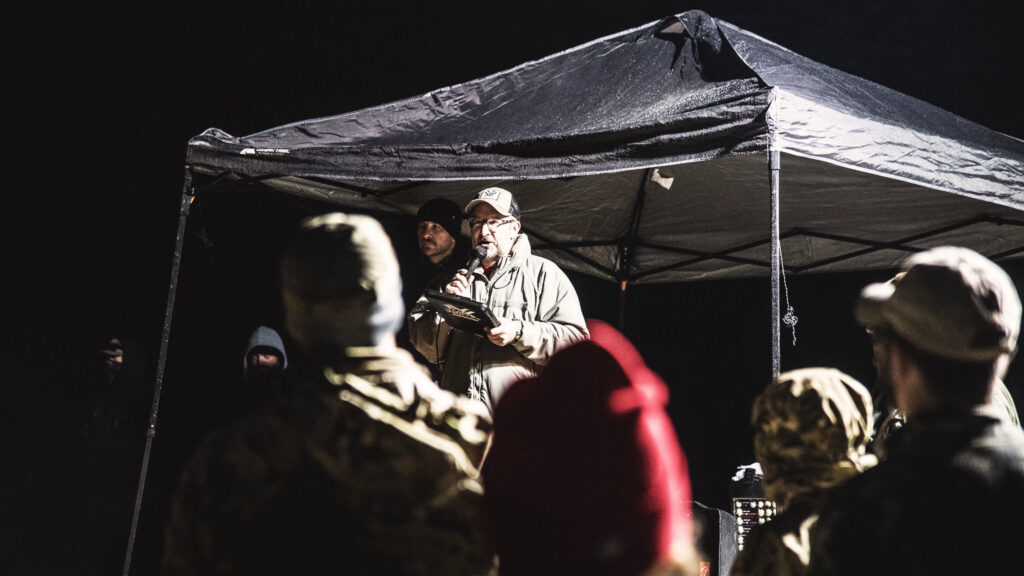
Our first ruck was right at two miles, starting in the dark and moving while the sun rose behind the cloud cover. The temperature was sitting in the low-40s and ended up staying there all day.
High & Low
At range 11 our first stage awaited, called High & Low. This stage began with a run up some bleachers with all of our kit, with vague instructions that target indicators would be visible. At the top there were no target cards or information at our location, so we went to glass scanning down range. There were cards hidden around the many berms with P (primary) and S (secondary) numbered indicators for which targets were to be engaged. To further complicate things, the shooters had to move laterally to find all the target information. Once the team was ready they headed for the shooting pits as designated by color, for alternating target engagement (in 1-2-3 sequence).
The targets were not in order from near to far, so either some quick ranging or working hasty holdover math was needed as targets changed. For Greg’s 1st target I found it at the bleachers, telling him I had his first target. Our miscommunication here was that he never found it and assumed I had his info handy. Once we got into the pits he fired his first round on what was his second target, costing us 2 points before we got him on the right target.
We recorded target info on arm-boards, and while I could I tried to get a range from the bleachers. The bleachers were about 25 yards behind the shooting position, so I made the adjustment when I was writing ranges on my arm-board. We got a fair amount of hits, even on some of the dreaded ruler targets (3″ wide and 15″ tall). Our score ended up being 16 out of 24 possible.
After this stage we had a 2.5 mile ruck going past the start point for one of the long-range stages at Range 4.
Ovals Throwback
The ovals was a Mammoth throwback stage. It was a gambling game with a significant amount of points available. The Jaworski/Gillenberger team had the best and a great score of 57, placing well ahead of everyone else, yet that wasn’t even half of the 120 points available!
Range 4 is a 1,000 yard range that is quite wide as well. Two sets of three crooked ovals were placed at 800 and 1,000 yards. The targets were in descending size order, with each smaller target worth additional points (1-2-3 pts). Each team member had 20 rounds to fire, starting with the secondary shooter for 10 shots, followed by the primary shooter and then repeating. For each shot fired the shooter had to call out which target they were engaging. If you failed to call the target, no points were given even if it was a hit. I got burned on one target myself, and it sounds like just about every other team forgot to call a target at least once or twice.
Where the targets were set at 800 yards it was perfectly flat area, providing zero feedback of any misses, particularly with the smaller .223 bullets. The primary shooter had the 1,000 yard array, which was located on the top of the far berm, also providing limited feedback. During Greg’s first 800 yard run it took about half of the magazine to get him on his largest target. When it was my turn, I took a good guess based off of Greg’s mile per hour wind call, and saw splash somewhere behind the target but no feedback otherwise. At that point I sacrificed a round and aimed for a point on the berm, refining my wind call with a visible bullet splash. My middle target was hung horizontally and had some wind forgiveness, so I attempted it and got a decent hit. After that I stayed on that one target and got a decent amount of hits despite the hazy and rainy conditions.
The conditions weren’t in our favor to try for the smallest plates, so we stayed on the middle plates for the rest of our shots. Our shooting earned us a 40, which was a tie for 2nd place. The stage winners here got on the small plate and hammered it, taking advantage of the points multiplier. As a note there was a bonus target that we found, but only got 1 shot off with an erroneous range before time expired.
Our next ruck took us back out the road to Range 9A and was about 1.9 miles.
Red Torsos
At Range 9A we were greeted by the ROs and given the brief for our next stage, which would involve both pistol and rifle shooting. Upon the start signal, the team would run with all gear in hand about 50 yards. The first shooter then moves to the shooting area and use his pistol to engage three torso plates of decreasing size and increasing distance. After three attempts per target, he places a cleared pistol in the dump bucket and moves to the rifle position. Now the second shooter would follow up to engage the same pistol array.
Next the first shooter engages a similar array about 300 yards away with the rifle. The way the targets were set, a carefully selected aiming point was necessary to lob the round on target over the target in front of it. After three attempts each with the rifle, the first rifle shooter cleared out for the second shooter to move in and repeat. On this stage there was also a bonus target hidden to the left of the target array.
Based upon the brief we thought we might have to shoot over an obstacle/wall and setup our gear appropriately. That ended up not being the case, but we stayed committed to our gear setup with a tripod and tall bipod and were still able to get a decent amount of hits. Once my shooting was done we still had about 20-30 seconds to scan for the bonus, which Greg found and talked me on for a quick hit. Including the bonus target we ended up with 33 points on this stage.
After our squad rotated through, it was time for a little rucking in the woods to the MOUT site for our final stage of Day 1. This was about a mile and a half, mainly on a dirt road through the woods.
MOUT Site
The MOUT site for Ft. Gordon is outside of the impact areas, so no live fire took place on this stage. This was an observation exercise, with teams starting at the bottom floor of a building. At the start signal, the team climbed two flights of stairs with all of their gear plus an additional 25lb bag. The surprise at the top was a barbed wire obstacle that had to be crawled through to get to the roof. Once on the roof the team had to locate up to 10 targets, recording distance, color and location on a map of the area. Finally, teams had to be back to the upper landing of the stairs before time expired to earn any points.
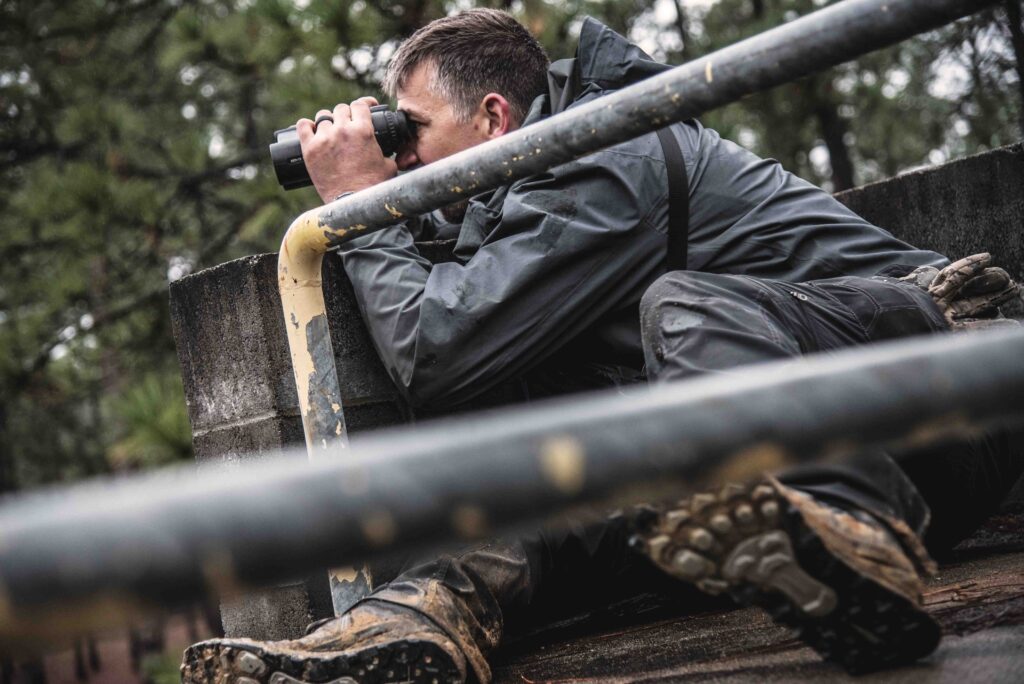
I led the way to the top with binos already mounted to our tripod. At the top we started on the left side of the roof, recording the few obvious targets. Then we split up our zones to scan, finding 5-6 of the targets. Once we felt we had found what was visible, we shifted on the roof with Greg going far right and me to the middle. From these locations we found the remaining targets except for 1, but our watch timer to get back in time had gone off indicating it was time to move. In the end we missed seeing the 1 target that was buried at the far right of the area, and our map drawing must have had something off as we earned 8 out of 10 points here.

Now that the stages for the first day were complete we had our final ruck of the day back to range 6. Once we all crossed the line, it was time to setup camp.
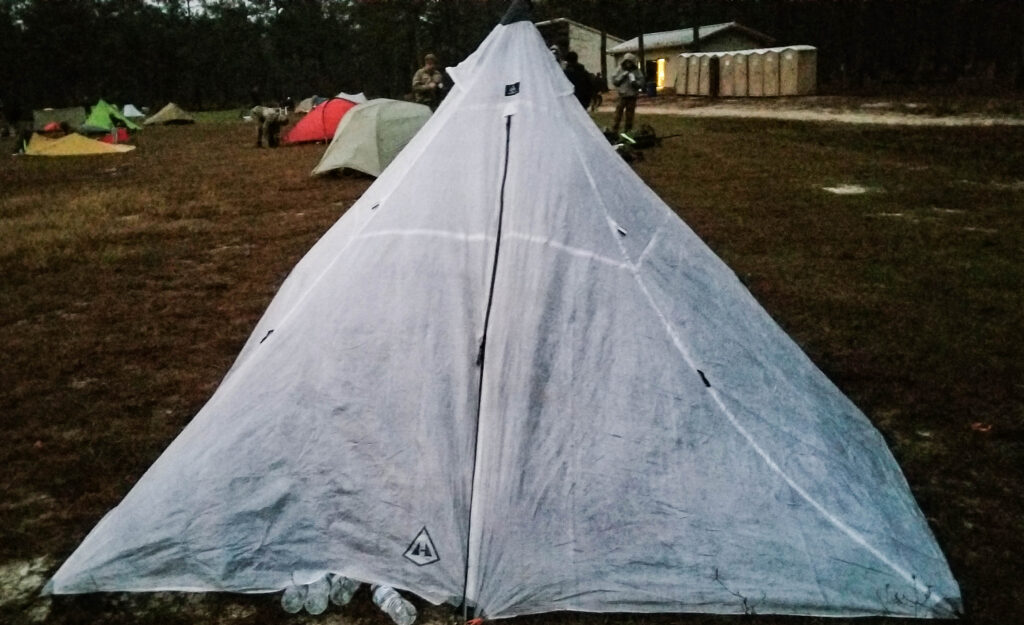
Day 2
Now that we’ve had a couple rucking and camping matches under our belts, I have to say the second morning is the hardest hump to get over. In the winter it’s generally cold, you don’t sleep as well, you’re sore and stiff and it’s easy to feel a little down. However once you get up and going it tends to get better, but this is where a treat or two can help lighten the mood.
Chris gave another morning briefing right at 6:30 AM, then it was a step off right on time at 7:00 once again. Our first ruck that morning ended up at 3.3 miles, at a brisk 32 degrees.
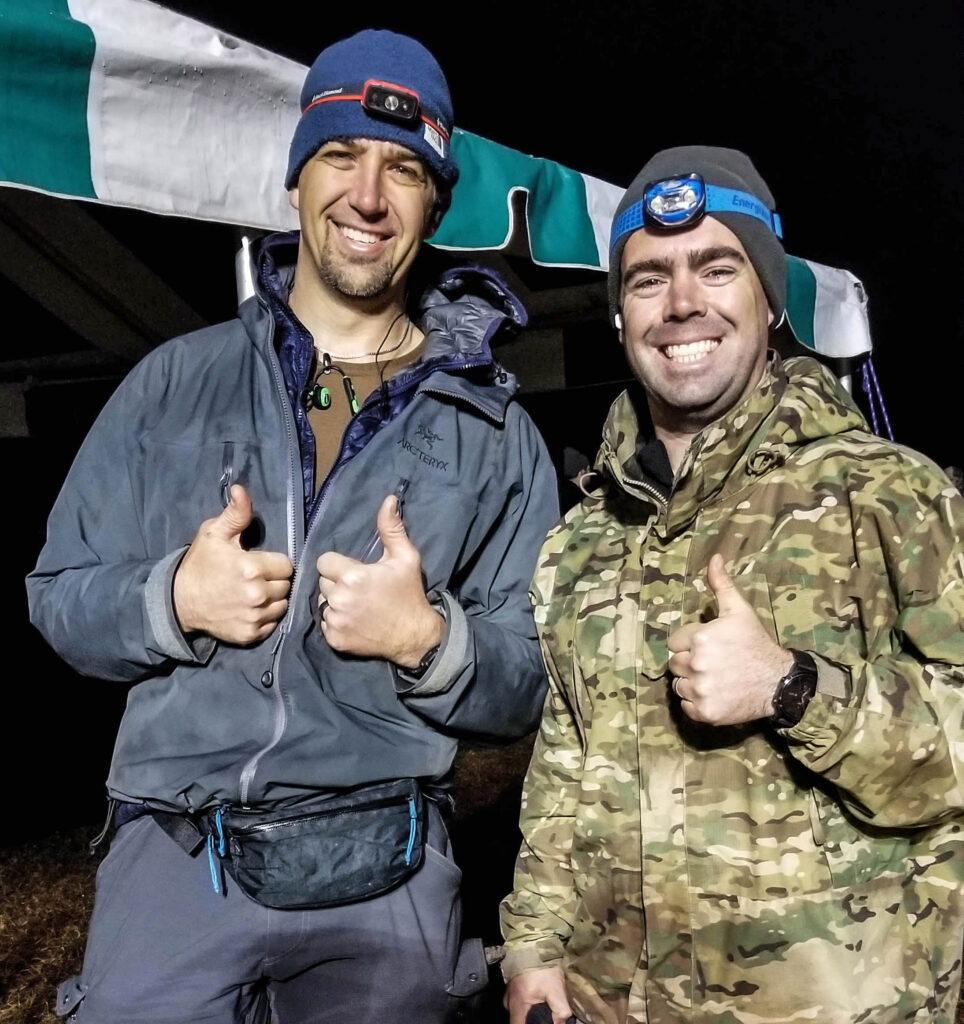
Tall Weeds
The training area that Tall Weeds was located was aptly named. A quick run up a small hill took you to the pistol shooting area where each team member had three attempts each at the four plates, then ditching cleared pistols. The team then moved into the area where the pistol targets were located and had to engage a series of rifle plates in color sequence. As the stage was appropriately named, either a tripod, partner support or just standing unsupported was needed to see the rifle plates. Adding to the challenge as the first squad of the day, we had the sun low to the horizon and behind the plates, making some very hard to see. We both got all of the possible pistol points, but I stayed too committed to finding one particular plate and Greg didn’t get to engage all of his rounds, so we ended up with a 41 on the stage. While a decent score, it was not up to our potential.
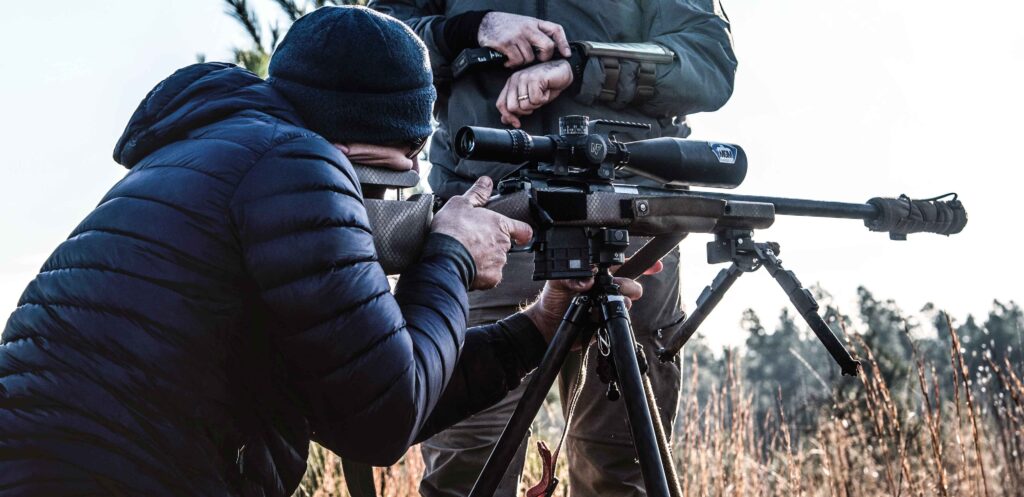
With our first stage completed, we retraced our route back to Range 6 for the next stage. Our return pace was slightly slower than our outbound time, but everyone on the squad made it with some time to spare.
No Comms
While titled No Comms, this stage should have been called “Silence, No Points For You!” The basic premise was there were three pistol targets and three rifle targets, shot in a follow the leader sequence. Each target could be hit three times for 1-point each, and the shooters had unlimited rounds. The catch was the team had one warning for any sound, uttering, talking or other verbal communication. A second infraction equaled a zero on the stage.
Our basic plan was to work in left to right fashion and be deliberate so that one could follow the other. The pistol targets were close together and easy to see, so no problems there. After clearing the pistols we dropped into the rifle position, finding the three targets spaced apart but easy enough to figure out. Since I was shooting first, there was a plus sign target as the leftmost target, and I crossed my fingers into a plus sign to identify where I was starting. While we had unlimited rounds we probably fired a couple extra pistol shots and maybe one rifle round, but like many teams we cleaned this stage (an uncommon thing for Mammoth!)
The next ruck was in warmer weather and we had just under 1.4 miles of movement to get to the next stage.
Run N Gun
At range 9 was the stage Run N Gun, a fast moving stage that was nearly impossible to complete. There were five shooting stations, the first two with pistol and then three with the rifle. The pistol positions consisted of 5 attempts for score at medium range pistol plate. Then the first rifle position was on an 18″ x 24″ plate at 325 yards, but the rifle had to be canted 90 degrees. Next was shooters choice, followed by standing unsupported at the last position. Each team member got an independent run and 2 minutes to do what they could. The best strategy was to play to strengths and earn the points for the shots you got off instead of trying to get every shot off.
Our pistol shooting here was just ok, but I got all of my hits at the canted position and ran out of time as I broke my shot from the fourth position. Greg got aligned on the wrong target for his 90 degree shots and burned a lot of his time there. In the end our score was a 19 and the best run was a 24, which was right at about 50% of points possible.
To get to the last stage of the day we had a short jaunt of .6 or so miles. These are often the hardest as the margin of error for a trip, slow down, etc is very minimal, however it was mostly downhill and not a problem.

No Barbed Wire
This stage got it’s name from prior years, where there was some form of barbed wire crawl to get up the stairs. However for 2021 the barbed wire was relocated to the MOUT site.
As for the shooting itself, one member of the team was to engage a pair of pistol plates for two hits each before they joined their teammate on a shooting tower. From here there were five color-coded targets per shooter, with some target distances given but others not. This range is particularly tricky with winds, especially at longer distances. I earned a few points but lost many rounds to the tall grass without any feedback. However Greg connected on quite a few targets and we walked away with 28 points, tying for a 2nd place run on that stage.
To wrap up the day we had about a 3/4 of a mile ruck to Range 6. At this point we were two complete days in, and it was time to set camp, get some dinner and get to sleep. We felt we were doing ok but not our best, which is a common feeling. As teams trickled in there were some tired looking teams, and it was easy to see who had been both conditioning before the match and who was prepared with good kit and nutrition.
Day 3
The final morning was a little easier to get up for knowing it was the last day. At this point we had shot two days of ammo and consumed two days of food so our pack was getting lighter as well. In addition to all of this, the competitors will conduct the days rucks and stages as an entire group. While everyone may be tired, sore, hungry and cold, the entire herd moving between stages seems to make the rucks easier. Knowing this, we made it to the morning brief somewhat looking forward to the day.
During the brief the top scores were announced and we were sitting in second place. However, the difference was not impossible to overcome if we stuck to our plan of being consistently decent and earning what we could, where we could. At 7:00 AM the group took off on what’s known as the lake route, as it’s a ruck route that passes several lakes on the base.
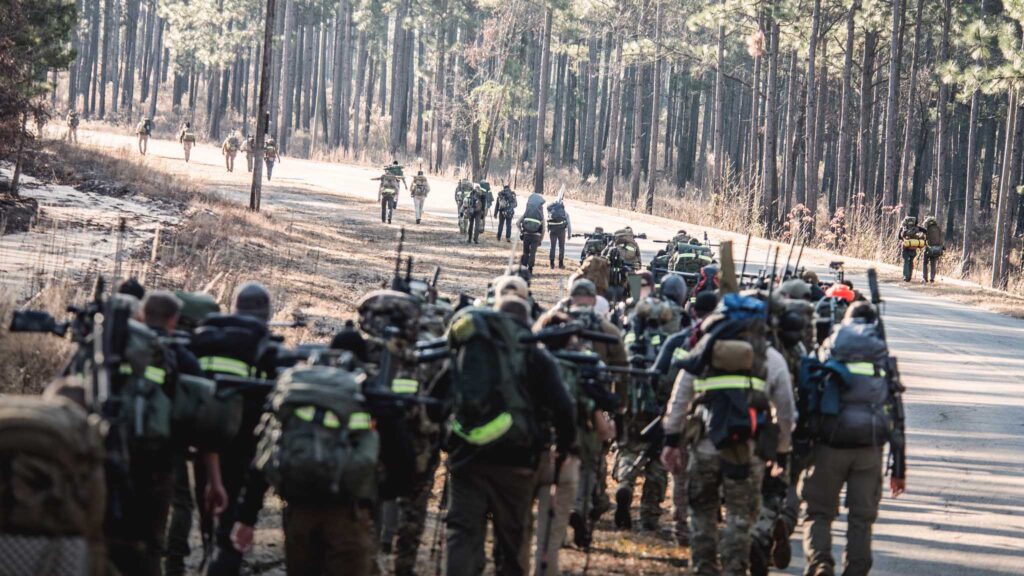
One Handed
Once we got to Range 4, teams filtered to their squad shooting positions. Since we were in squad one we made our way down the firing line to the left of everyone else. Everyone was given identical briefs by the firing point ROs, and targets were color coded so you knew what to shoot. One Handed consisted of engaging targets with one hand as implied. The targets were at 700 yards for the secondary shooter and 900 yards for the primary. The secondary shooter fired five rounds followed by the primary shooter, able to do it with both hands at first. After the first five rounds each, two additional strings per shooter were done with the support hand holding onto a dumbbell. The dumbbell didn’t have to be held off the ground, but holding onto it ensured no extra support of the rifle.
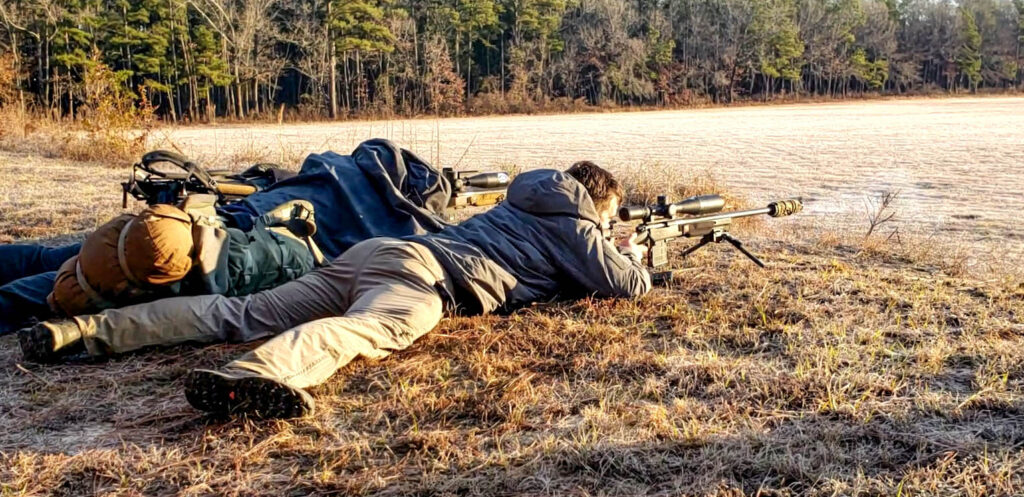
As I mentioned earlier about the Ovals stage, this range gives very limited feedback due to it being extremely flat and having firing point berms nearly every 100 yards. We were also facing into the sun as it came over the horizon, adding to the difficulty. However we were able to get on target fairly quickly and earn points. This was one stage where the extra weight in my stock paid off as it helped with settling the gun and good follow-through on the shots with one hand only. We were one of the few teams to break into the 30s for score, finishing with a 31 our of 48 possible.
With the first mass stage completed, it was time for a 2.5 mile ruck out to Range 11.
Awkward
Once again as teams filtered in, it was off to the assigned squad lanes. The brief for Awkward stated that each shooter had to engage a pistol plate at about 45 yards with 5 rounds strong hand only and 5 rounds weak hand only, then ditch a cleared pistol. Once both shooters did this, the secondary shooter engaged a small IPSC plate at 325 from a standing position, with the rifle supported by their partner. After five attempts, the primary shooter went prone and engaged a ruler target at the same distance for five shots as well.
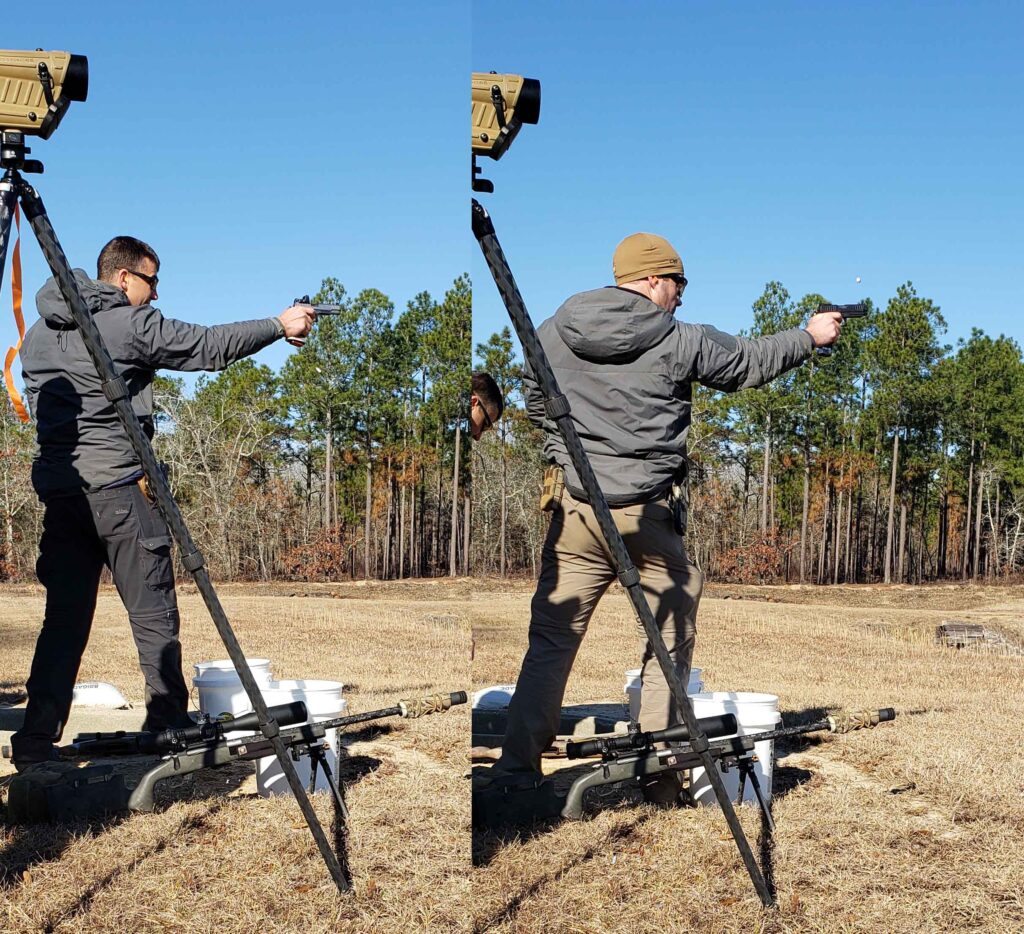
Our run began with a lower than expected pistol hit ratio. After ditching the pistols, we established a pretty solid position with me facing Greg and locking my arms out for rifle support. He was able to get 3/5 hits and then I had 5 good hits, ultimately netting 22 points.
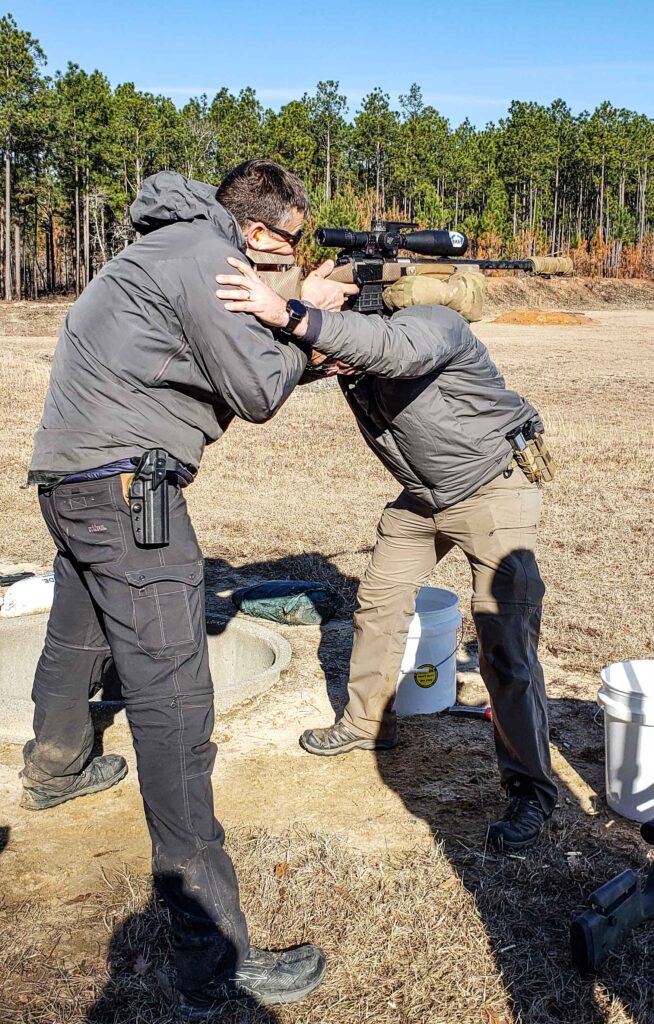
The Final Ruck
After our second stage of the day, it was time for the final ruck of the event. This would be a five miler across rolling hills to get to the finish line. Before step off, there were quite a few trashcans filled with food, packaging, some nasty clothes and other items no longer deemed necessary for that last ruck. With 80 minutes to cross the line, our step off time was around 11:40 AM and the temp had warmed up to about 50 degrees with the sun shining…just about ideal for a ruck.
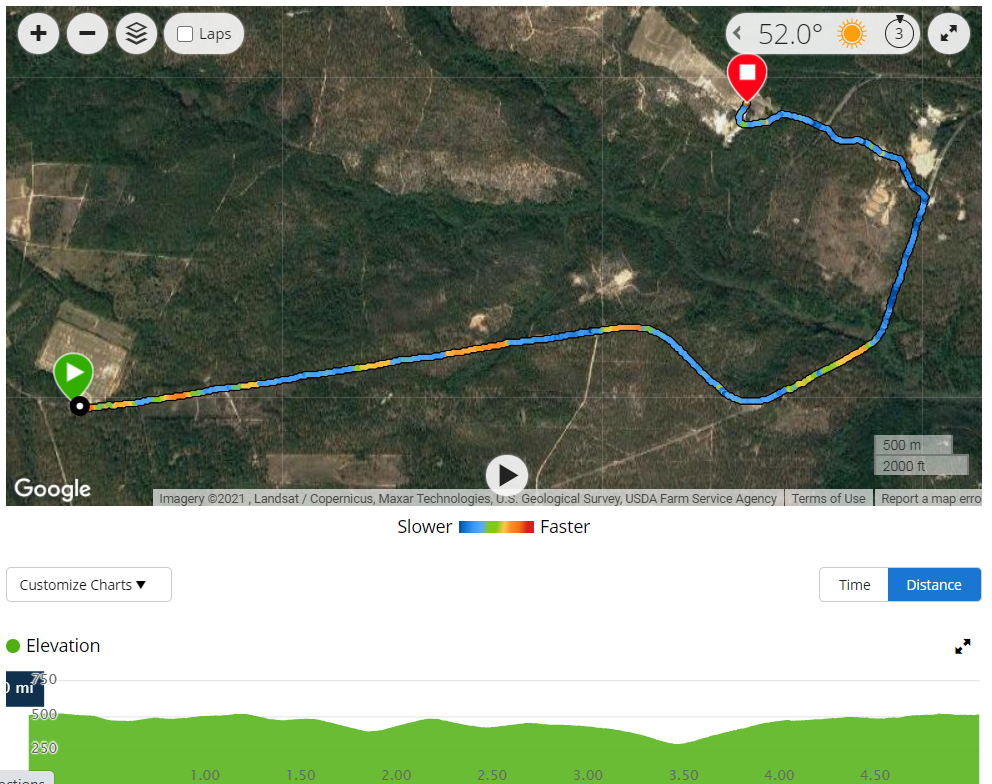
The first couple of miles have plenty of up slopes but also downhills, so it’s important to push through and build up a time reserve on those downhills. The reason for that is somewhere around Mile 3.5 begins the heart-breaker of a hill that feels like it goes on forever and at an ever increasing rate. In actuality it’s not impossible, but the slowing down of your pace adds a little anxiety in the to push to get to the top. Once on top there’s a walk through some sand pits and then the final half mile of asphalt to the end.
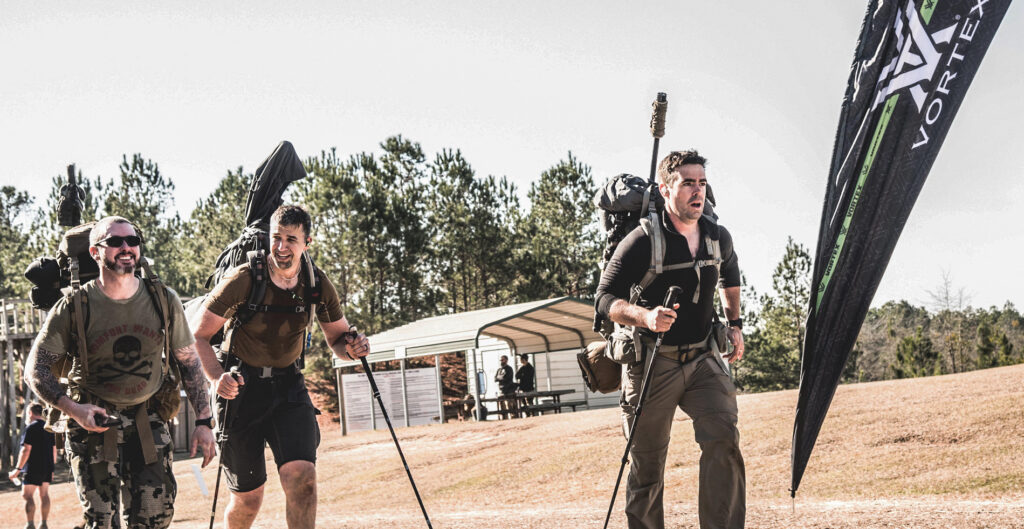
We finished the final ruck with about 4 minutes to spare, averaging a 15:21 pace over the ruck. However, if you look at an average pace for each mile you can see we started out much quicker, but needed that extra time for when things slowed down at the end with the big hill and sand traps.
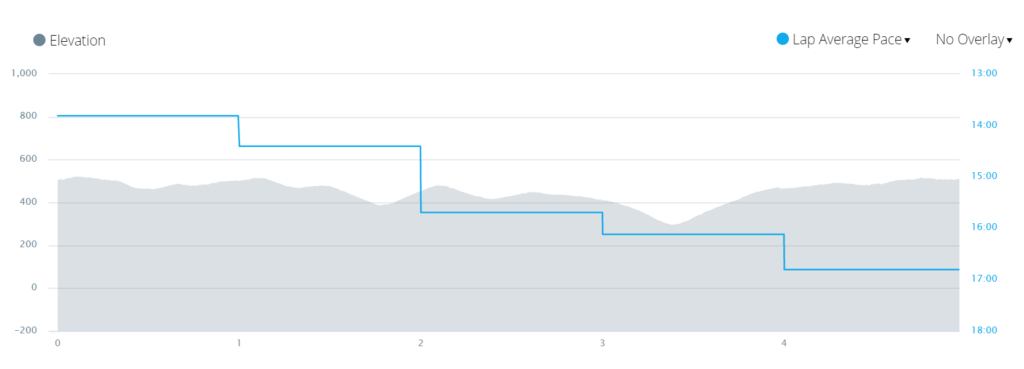
Near and Far
Despite the final ruck being over, there was one last shooting stage. This was a three round exercise, with two shots at 750 yards on a spade shaped target, followed by one shot at 100 yards for the Accushot Challenge. There were points awarded for where the round hit on the target as well. The winner of the Accushot Challenge also received a $300 cert from B&T Industries. I made a second round hit on the spade at distance and earned a point for hitting the circle on the Accushot target, while Greg made a 1st round hit and also hit inside the circle of the close target. Our total for the stage was 6 points, finishing the 2021 Mammoth Sniper Challenge for us.
The Rucking
One of the more infamous aspects of the match is the rucking between stages. All of the rucks must be completed under 16 minutes per mile standards. If someone on the team fails a ruck, the team is out of contention and grouped with those that drop during that day. In short you do what you have to and get to the end.
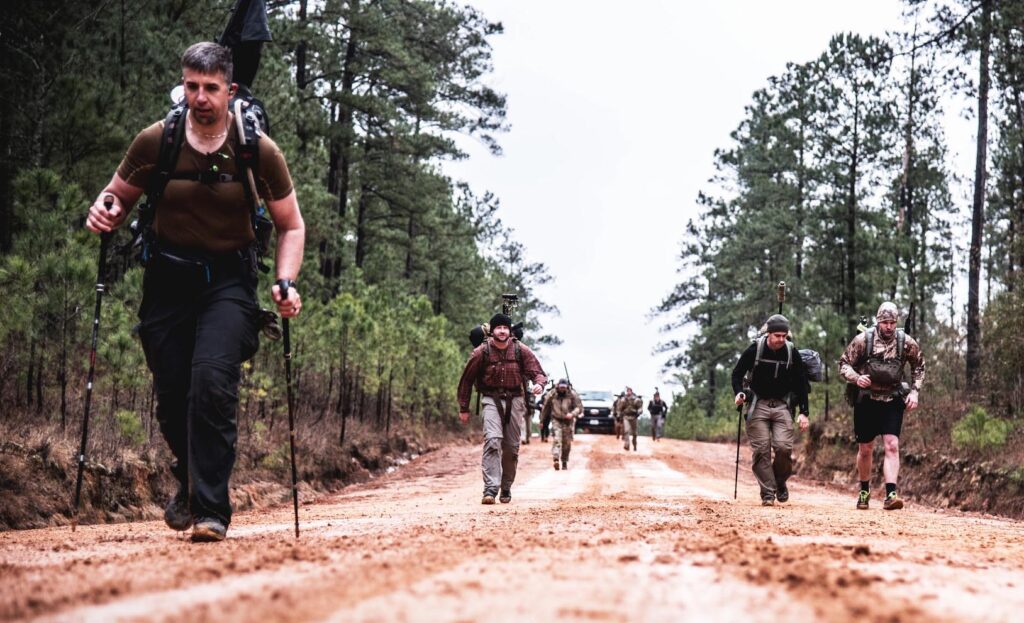
While rucking might sound difficult, it is not different than any other activity that you can adapt to. The key is preparing a couple months beforehand. Physically being able to make the times is a first goal, followed by making it under weight. Along the way you’ll figure out what shoes and socks work best, if you need to adjust your pack, and any other tricks you might need to survive.
My goal leading up to the match was to make four mile rucks in less than an hour, with a pack weight of about 55-60 pounds. This was a weekly test around any other prep work with lighter bags, running or other forms of exercise. Tracking your pace and mentally calibrating your time standards is a good form of preparation as well, after a while you can feel if you’re doing well or not without even looking at a watch or phone app.
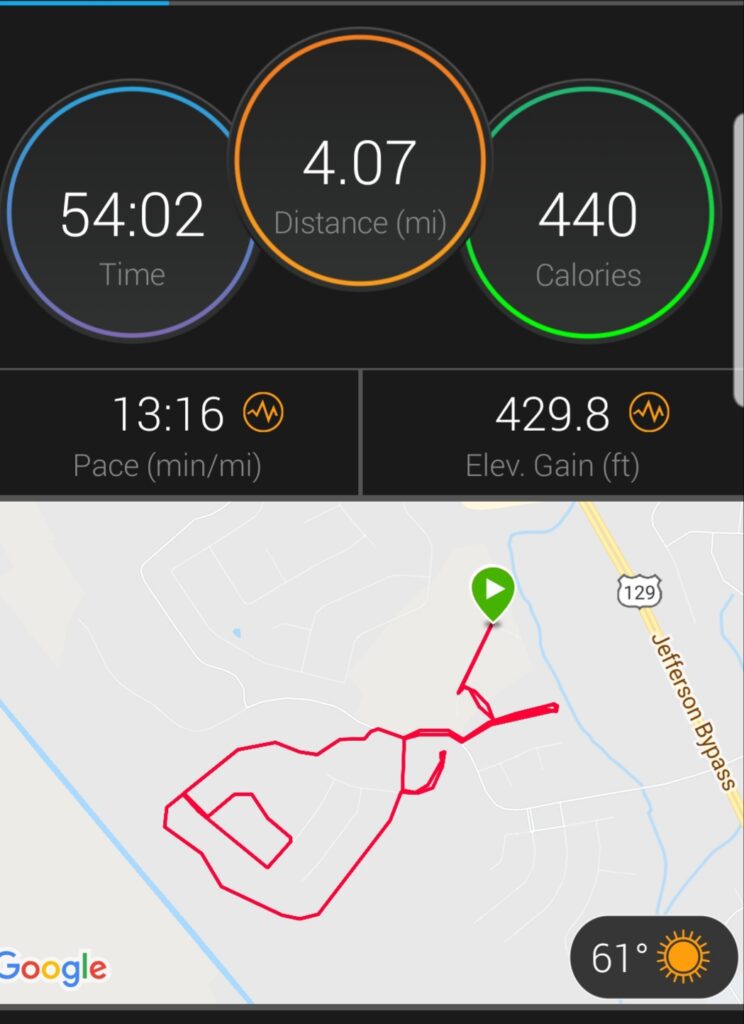
During the match you not only have to make the rucks but then perform on shooting stages. With stages being blind there was not a significant advantage to where you are at in the shooting order, so the best strategy seems to be making it with just a little time to spare. It’s possible to maintain a 15 minute mile standard across the terrain, the formula being jogging/shuffling on the downhills with momentum, power walking the flat stretches and then walking with purpose on the uphills. Tracking your distance relative to time and knowing if you have a little time to spare against the standard can be mentally calming as well.
We both had Garmin Fenix watches tracking our movements, including pace, distance, elevation changes, heart rate and more. Our overall match average pace was 15:15 min/mile. Here is a breakdown of all of the rucks we had for the match.
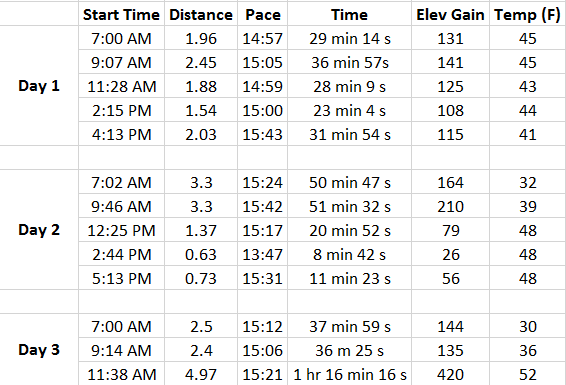
The Camping
The distinction between Regular and Toughman divisions is who gets to carry everything for the weekend and camp outside. For the campers, there were a variety of setups to make it through the night. Most teams had some form of a tent, but there were a few bivy sacks and tarp contraptions. Our setup was not spacious but had some room to work under cover if it was raining or cold out (which it was both).
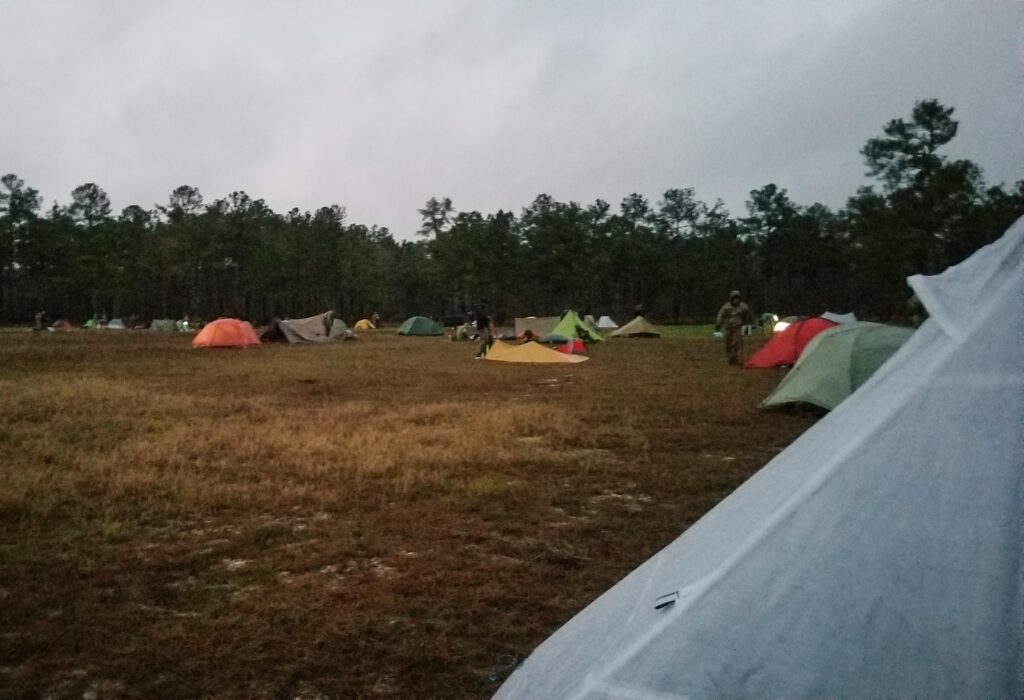
When we did get to the campsite, we didn’t waste time. While Greg would work on getting the tent setup, I would begin prepping our dinner and some hot beverages. Once the tent was set, we’d get our packs laid out, air out shoes and wet clothes to dry and then chow down. Because we’d still have an early start, not much time was wasted getting some things prepped for the morning and then it was time to pass out for the day. Pro Tip: A Tylenol PM and ear plugs work wonders. While we didn’t sleep the best, we were able to get sleep both nights and stay warm (which not everyone could say.)
Final Thoughts
Mammoth Sniper Challenge is not an easy time. It’s surviving the challenges thrown out by rucking, weather conditions and living out of your backpack for a couple days…then performing the best you can to earn points.
Final placement at the match is earned through points accumulated by shooting. The stages are generally blind, with limited time and information given. A simple plan executed well earns a top score. Unlike many other shooting disciplines, the amount of points earned is nowhere near the points possible. There is mental toughness required to stay in the game after earning low point values, as even a low score could be the stage winner. Ultimately, being consistent in getting a decent score without major screw-ups on everything will earn a good placement. Then if a stage plays to a team strength, rack up what extra points you can against the rest of the field.
Scores Analysis

In doing some scores analysis, I calculated the average of the Top 17 and Top 5 teams for each stage. Then I compared our performance versus these averages. Of note, the stages with the long-range precision shooting were strengths for us and the rest of the Top 5. Our one under-potential score was the Tall Weeds stage. Usually a complex stage with finding multiple targets like that is a strength, but we fought the sunshine and made some mental errors, falling short on our score there. Also, we didn’t have any stages this year that we outright won.
Greg and I began Day 3 in second place, but we didn’t let that get to us and shot decent scores on the remaining stages. Doing this enabled us to pull ahead by the end and earn both a Toughman division win and the highest overall score for the match. At the end of the past few years we were convinced we wouldn’t need to do it again, but then the crazy sets back in and you find yourself wanting to go through it all again.
For those interested in this, early July is registration for the event at https://www.g3dynamics.com/. The 2022 match steps off on January 7, 2022 so there’s no time like the present to start getting ready.
NOTE: We were one of a few teams followed for a mini-series about the Mammoth Sniper Challenge. This should premiere in the spring of 2021 and we’ll certainly share info once we have it.
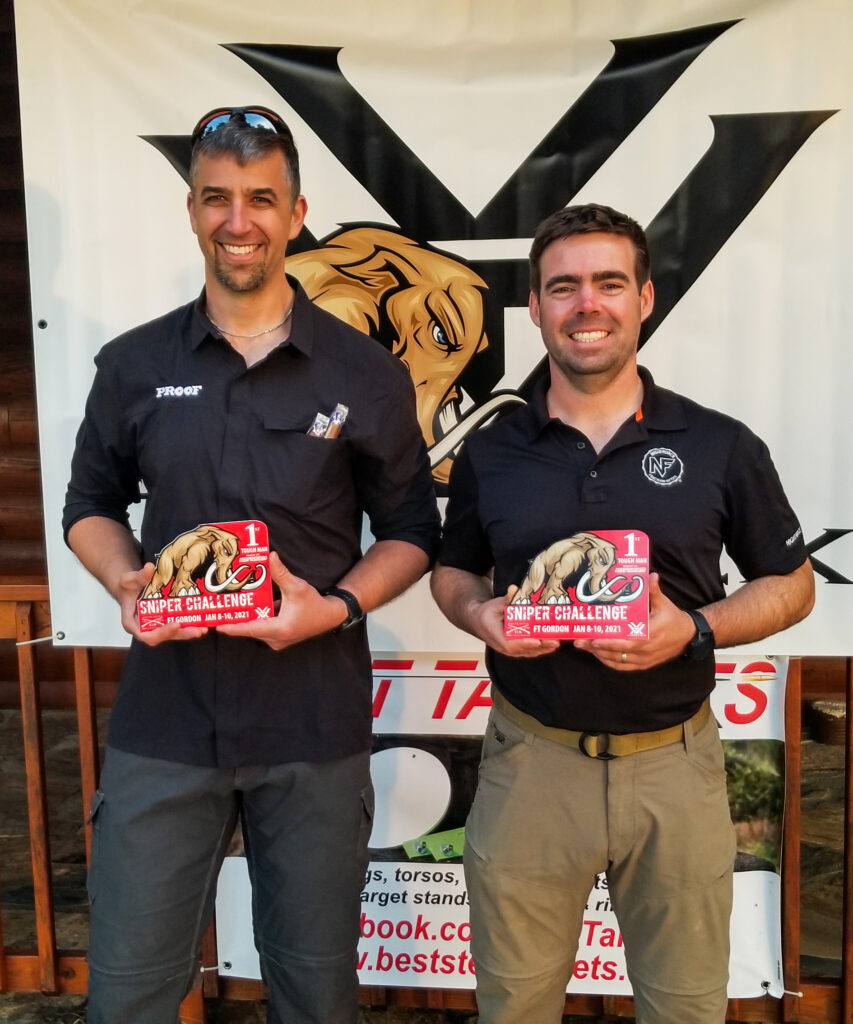
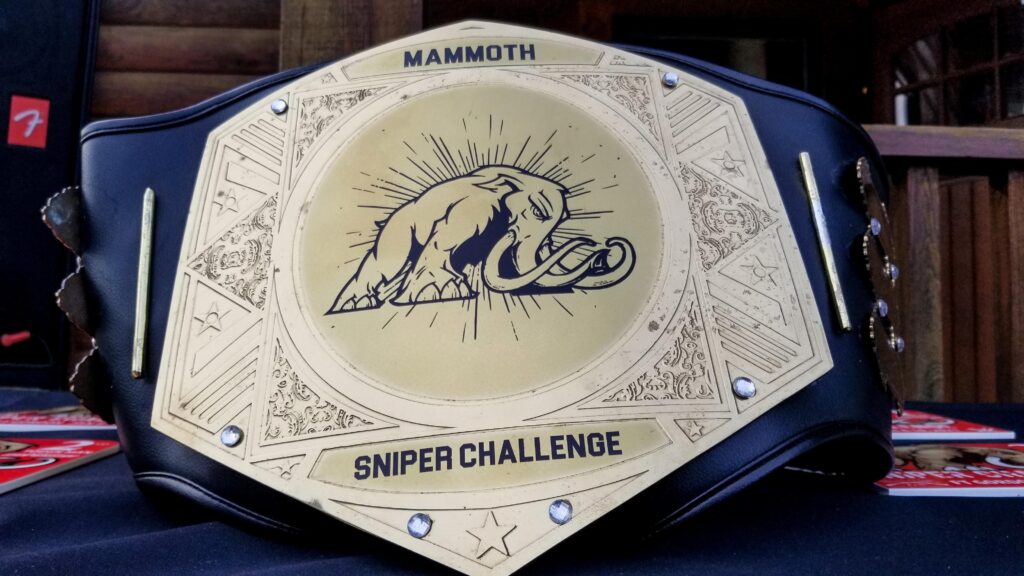
Final Scores
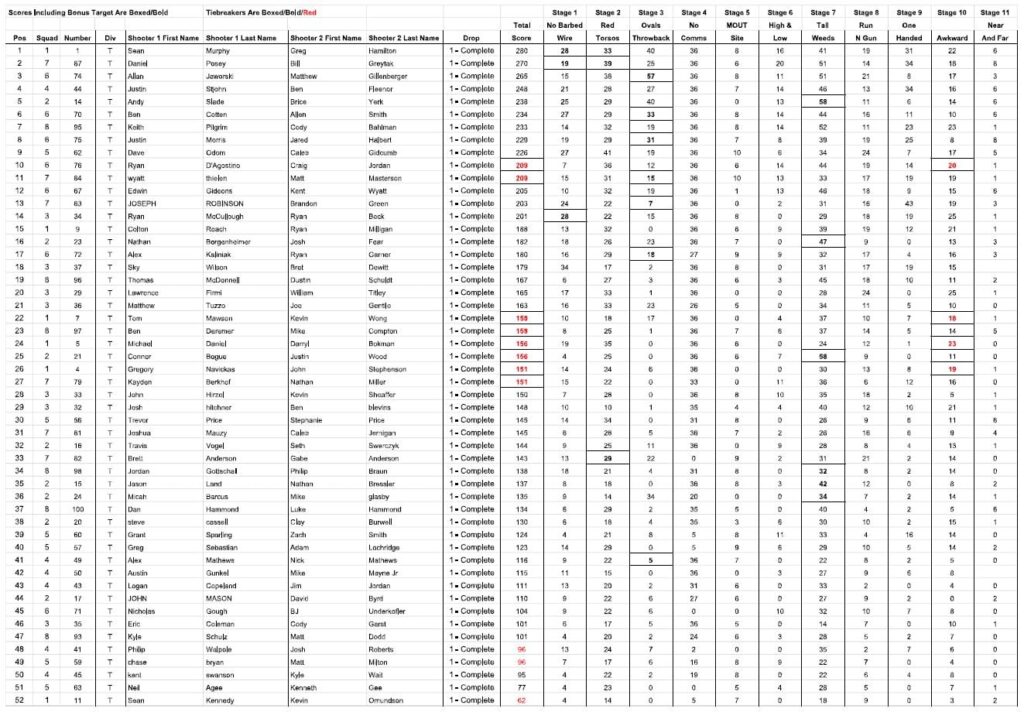
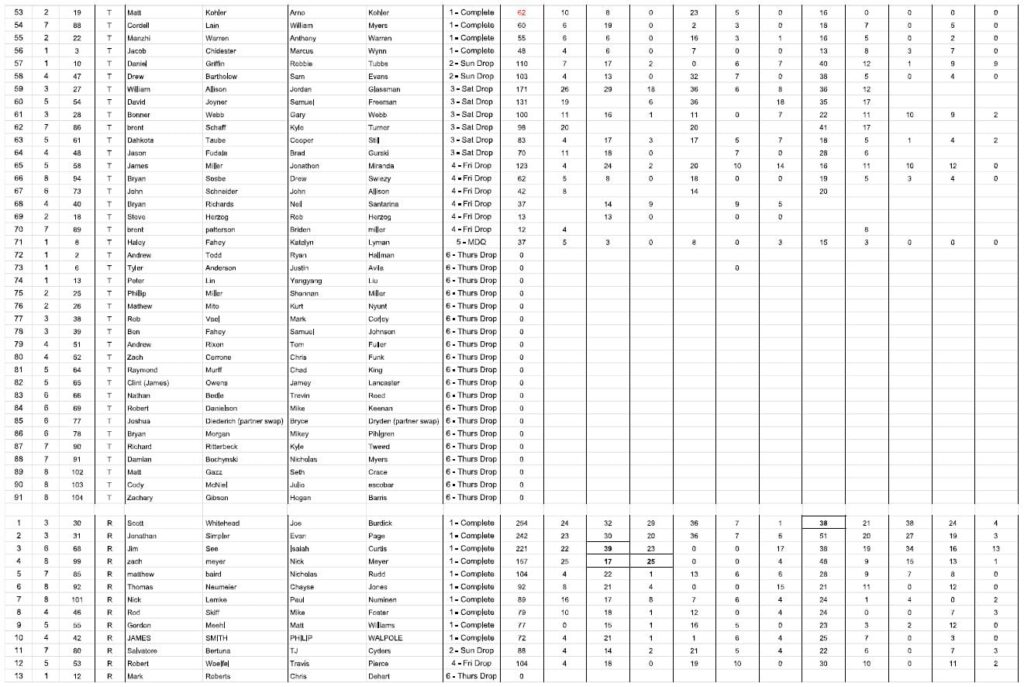
Mammoth Competitor Info
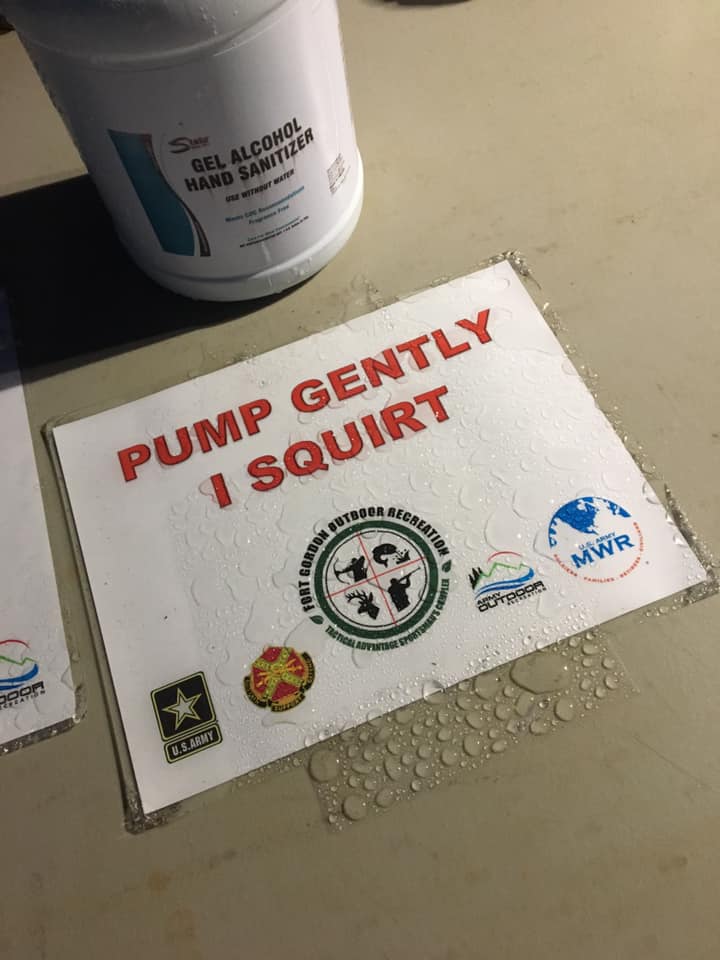

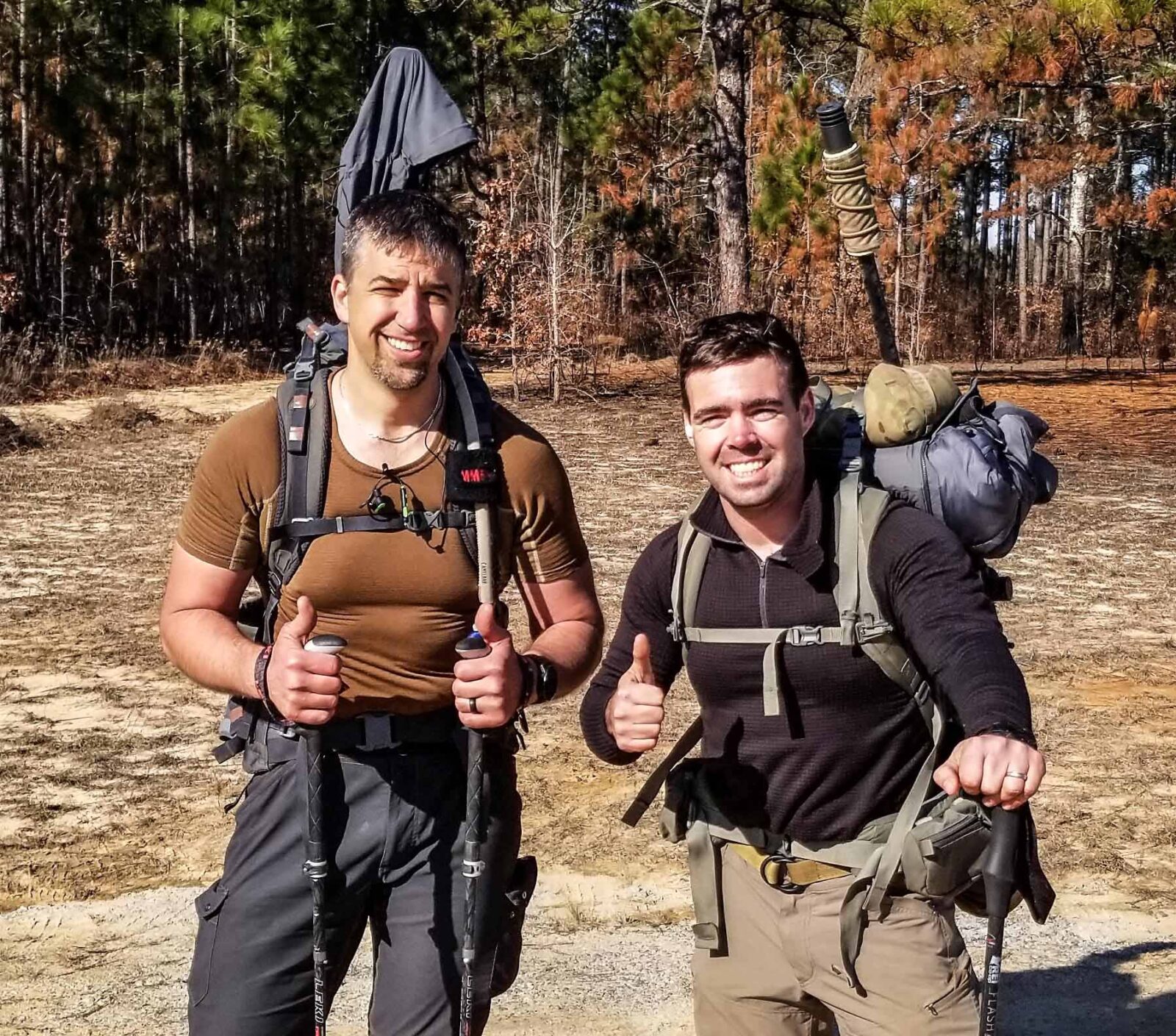
What a great competition! Thanks for taking the time to write about your training, equipment, and experiences.
How did you carry pistols during the rucks and during the stages?
We used Safariland ALS holsters for stages, but then took them off and put in our bags for rucks.
What height/model tripod did you use?
It was a Really Right Stuff SOAR tripod with 1 series legs.